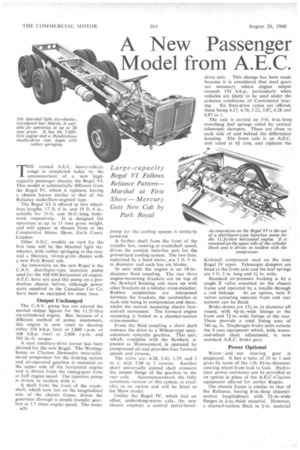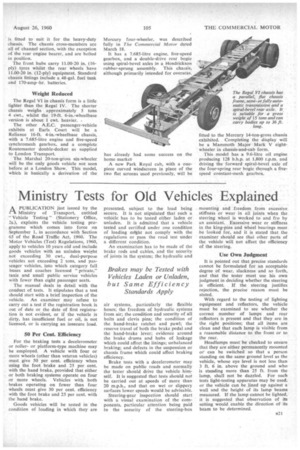A New Passenger Model from A.E.C.
Page 54

Page 55

If you've noticed an error in this article please click here to report it so we can fix it.
THE revised A.E.C. heavy-vehicle range is completed today by the announcement of a new highcapacity passenger chassis, the Regal VI. This model is substantially different from the Regal IV, which it replaces, having a chassis layout similar to that of the Reliance underfloor-engined type.
The Regal VI is offered in two wheelbase lengths, 17 ft. 6 in. and 19 ft. 6 in., suitable for 33-ft. and 36-ft.-long bodywork respectively, It is designed for operation at up to 15 tons gross weight, and will appear in chassis form at the Commercial Motor Show, Earls Court, London.
Other A.E.C. models on view for the first time will be the Marshal light sixwheeler, with rubber springing at the rear, and a Mercury 14-ton-gross chassis with a new Park Royal cab.
An innovation on the new Regal is the C.A.V. distributor-type injection pump used for the A14 690 horizontal oil engine. A.E.C. have not used this pump on a production chassis before, although power units supplied to the Canadian Car Co. have been so equipped for some time.
Output Unchanged
The C.A.V. pump has not altered the quoted output figures for the 11.31-litre six-cylindered engine. But, because of a different method of power assessment, this engine is now rated to develop either 154 b.h.p. (net) at 1,800 r.p.m. or 168 b.h.p. (net) at 2,000 r.p.m. and 505 lb.-ft. torque.
A neat auxiliary-drive layout has been devised for the new Regal. The Westinghouse or Clayton Dewandre twin-cylindered compressor for the braking system and air-operated gearbox is mounted on the upper side of the horizontal engine and is driven from the timing-gear train at half engine speed. The injection pump is driven in tandem with it.
A shaft from the front of the crankshaft, which now lies on the longitudinal axis of the chassis frame, drives the generator through a simple transfer gearbox at 1.7 times engine speed. The water B2() pump for the cooling system is similarly powered.
A further shaft from the front of the transfer box, running at crankshaft speed, drives the cowled, twin-fan unit for the pressurized cooling system. The two fans, separated by a fixed stator, are 1 ft. 9 in. in diameter and each has six blades.
In unit with the engine is an 18-in.diameter fluid coupling. The rear three engine-mounting brackets are on top of the flywheel housing and mate up with other brackets on a tubular cross-member. Rubber sandwiches are interposed between the brackets, the sandwiches at each side being in compression and shear, whilst the central mounting checks foreand-aft movement. The forward engine mounting is bolted to a channel-section cross-member.
From the fluid coupling a short shaft conveys the drive to a Wilson-type semiautomatic epicyclic gearbox. This unit, which, complete with the flywheel, is known as Monocontrol, is operated by compressed air and provides four forward speeds and reverse.
The ratios are: 4.28, 2.42, 1.59, and 1 to 1; with 5.98 to 1 reverse. Another short universally jointed shaft connects the output flange of the gearbox to the rear axle. Automonocontrol, the fully automatic version of this system, is available as an option and will be fitted to the Show model.
Unlike the Regal TV, which had an offset, underslung-worm axle, the new chassis employs a central spiral-bevel
drive unit. This change has been made because it is considered that steel gears are necessary where engine output exceeds 150 b.h.p., particularly when vehicles are likely to be used under the arduous conditions of Continental tour ing. Six final-drive ratios are offered. these being 4.27, 4.70, 5.22, 5.87, 6.28 and 6.87 to I.
The axle is carried on 5-ft. 4-in.-long overslung leaf springs aided by vertical telescopic dampers. These are close to each side of and behind the differential housing. The front axle is an A.E.C. unit rated at 61 tons, and replaces the is
An innovation on the Regal VI is the use of a distributor-type injection pump for the 11.31-litre horizontal engine. It is mounted on the upper side of the cylinder block and is driven in tandem with the compressor.
Kirkstall component used on the later Regal IV types. Telescopic dampers are fitted at the front axle and the leaf springs are 5 ft. 2 in. long and 31 in. wide.
Standard air-pressure braking is by a single E valve mounted on the chassis frame and operated by a treadle through a rod linkage. As an option, twin E valves actuating separate front and rear systems can be fitted.
Brake drums are 151 in. in diameter all round, with 41-in.-wide linings at the front and 71-in.-wide linings at the rear. These provide a total lining area of 746 sq. in. Diaphragm brake units actuate the S cam equipment which, with wormand-wheel slack adjustment, is now standard A.E.C. brake gear.
Power Optional Worm and nut steering gear is employed. It has a ratio of 33 to I and gives G turns of the 1-ft. 81-in.-diameter steering wheel from lock to lock. Hydrosteer power assistance can be provided as an option in place of the A.E.C.-Clayton equipment offered for earlier Regals.
The chassis frame is similar to that of the Reliance, having 8-in.-deep channelsection longitudinals with 21-in.-wide flanges in 1-in.-thick material. However, a channel-section flitch in +-in. material is fitted to suit it for the heavy-duty chassis. The chassis cross-members are all of channel section, with the exception of the rear engine bearer, and are bolted in position.
The front hubs carry 11.00-20 in. (16ply). tyres whilst the rear wheels have 11.00-20 in. (12-ply) equipment. Standard chassis fittings include a 48-gal, fuel tank and 170-amp--hr. batteries.
Weight Reduced
The Regal VI in chassis form is a little lighter than the Regal IV. The shorter chassis weighs approximately 5 tons 4 cwt., whilst the 19-ft. 6-in.-wheelbase version is about 1 cwt. heavier.
The other A.E.C. passenger-vehicle exhibits at Earls Court will be a Reliance 16-ft 4-in.-wheelbase chassis, with a 7.685-litre engine and five-speed synchromesh gearbox, and a complete Routemaster double-decker as supplied to London Transport.
The Marshal 20-ton-gross six-wheeler will be the only goods vehicle not seen before at a London Show. This model, which is basically a derivation of the
Mercury four-wheeler, was described fully in The Commercial Motor dated March 18.
it has a 7.685-litre engine, five-speed gearbox, and a double-drive rear bogie using spiral-bevel axles in a Hendrickson rubber-sprung assembly. This chassis, although primarily intended for overseas.
has already had some success on the home mark ct A new Park Royal cab, with a onepiece curved windscreen in place of the two fiat screens used previously, will be fitted to the Mercury 14-ton-gross chassis exhibited. Completing the display will be a Mammoth Major Mark V eightwheeler in chassis-and-cab form.
This model has a 9.6-litre oil engine producing 128 b.h.p. at 1,800 r.p.m. and driving the forward spiral-bevel axle of the four-spring rear bogie through a fivespeed constant-mesh gearbox.




















































































































